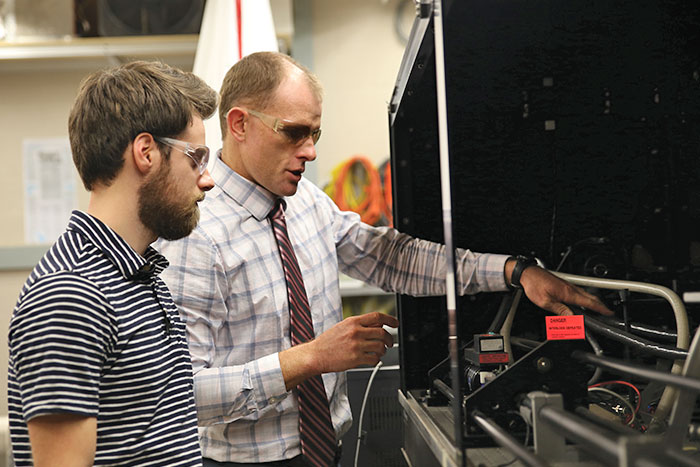On the heels of Oregon’s costliest wildfire season, researchers at Oregon State University are ramping up efforts to better predict how the blazes behave, including how they generate fire-spreading embers.
In 2018, in Oregon alone, the cost of fighting fires exceeded half a billion dollars, according to the Northwest Interagency Coordination Center, which provides logistical support and intelligence for federal and state wildland fire suppression agencies. That year, Oregon saw 1,880 fires burn 1,322 square miles — more land area than the state of Rhode Island. Moreover, fire damage and smoke inhalation not only took a toll on the health of some Oregonians; it significantly impacted three of Oregon’s largest industries: agriculture, timber, and tourism.
Violent wildfires are common in the western U.S. and Canada, where heat, drought, and frequent thunderstorms create ripe conditions. But as global temperatures rise, the number, duration, and intensity of wildfires is also expected to increase.
An Oregon State team led by David Blunck, associate professor of mechanical engineering, has been chosen by the U.S. Department of Defense Strategic Environmental Research Development Program to spearhead a new four-year, $2.1 million effort to study the burning of live fuels, such as live trees and bushes.
“Although a large number of wildfires studies have only focused on dead fuels, most wildfires involve live fuels or a mixture of live and dead fuels,” said Nathan Gardner, a graduate student in Blunck’s research group. “This research will enable the fire community to better model and more accurately predict the behavior of wildfires involving live fuels.”
The work is built around the theory that there are likely just a handful of factors — such as pyrolysis, the decomposition of fuels resulting from high temperatures, and the products of that decomposition — that cause differences in burning behavior, such as the time required to ignite, when live fuels burn.
“Most live fuel studies tend to be fuel-specific, controlling for variation in burning behavior based on time of year and moisture content, but with those results, it’s hard to know how new fuels will burn, or even how the same fuel will burn outside the conditions that have been studied,” Blunck said. “So, it’s really better to understand what’s driving the sensitivity when you have different fuels. Our theory is that it’s just a few processes that cause the differences when you burn different live fuels, and if we can understand what they are, we can better predict how new species would burn.”
Blunck and his colleagues will use a combination of lab work, modeling, and field studies to forecast ignition, burn rate, and fuel consumption mixtures for live and dead fuels that can ultimately help fire managers more effectively plan prescribed burning as well as wildfire responses.
As part of that same effort, Kyle Niemeyer, assistant professor of mechanical engineering, will lead the modeling of physical processes that control the burning of live fuels and Chris Hagen, associate professor of energy systems engineering at OSU-Cascades, will guide research examining the products released into the atmosphere during burning, such as methane and carbon monoxide.
Leading up to the current research, Blunck’s group, in partnership with the U.S. Forest Service, has examined the burning behavior of more than 100 trees — one, three, or five at a time — including Douglas fir, grand fir, western juniper and ponderosa pine, between 10 to 15 feet tall.
“That height is not very large from a forest perspective, but for testing for wildfire purposes evaluating trees of this height is typically not done, and never for the number of trees that we have burned,” Blunck said.
Most wildfire research, Blunck explains, involves either prescribed burns or work in a laboratory on individual samples up to a size of roughly one meter.
“In the lab you can control all the parameters like temperature, size and moisture content, but how well do the results scale?” he said. “With a prescribed burn, you’re researching under actual conditions, but with the data you get, it’s very hard to understand cause and effect. There’s so much out of our control that it’s hard to know what’s driving the various phenomena.”
But Blunck’s work is defined by the experiments his team has conducted on an intermediate scale with an unrivaled sample size. “With trees that are about 10 feet tall, we can bridge the scales between the laboratory and prescribed burns,” Blunck said. “We can look at many species and start to vary the parameters we think are important.”
“Doing research in an area that feels significant is exciting,” Gardner said. “Being aware of and seeing all the wildfires that happen every year, it is easy to see a need for what we’re doing.”
Original post https://alertarticles.info
